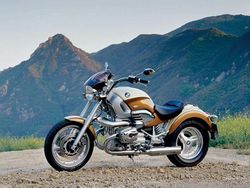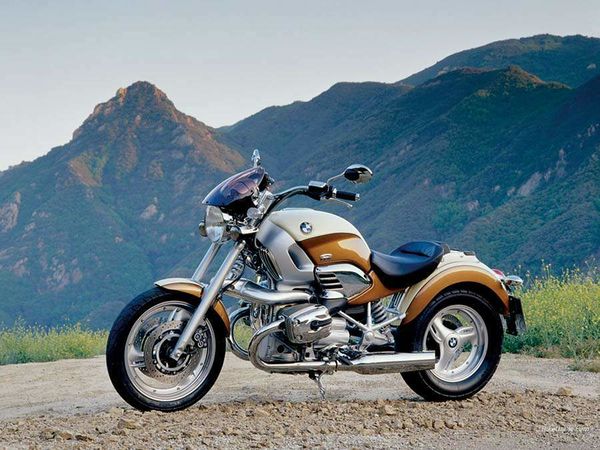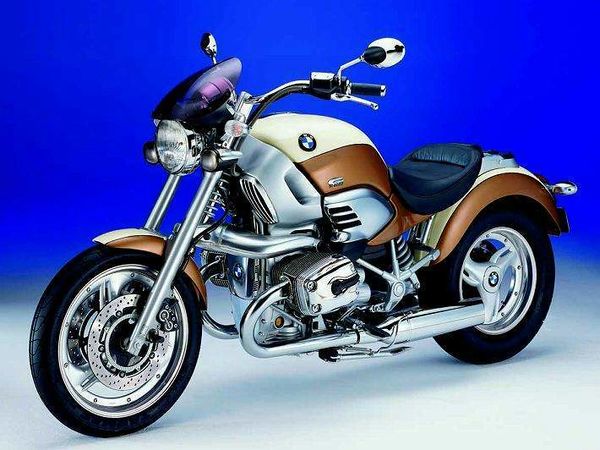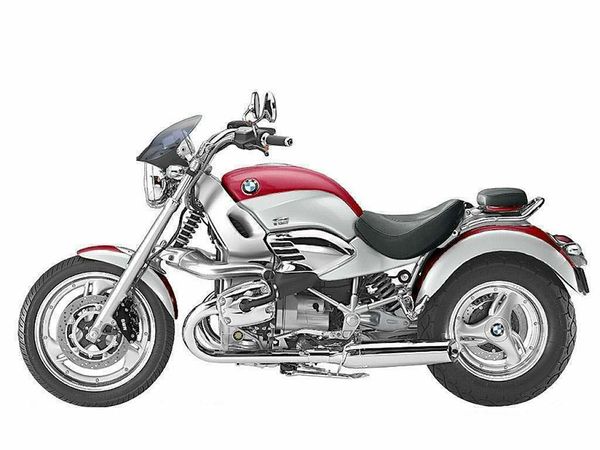BMW R1200C Independent
 |
|
| BMW R1200C | |
| Manufacturer | |
|---|---|
| Also called | R1200C - R1200C Avantgarde, R 1200 C - R 1200 C Avantgarde, R1200C Independent, R 1200 C Independent, R1200C Independence, R 1200 C Independence, R1200C Montauk, R 1200 C Montauk, R1200C Classic, R 1200 C Classic, R 1200 C |
| Production | 2003 - 05 |
| Engine | Four stroke, two cylinder horizontally opposed Boxer, 4 valves per cylinder |
| Compression ratio | 10.0:1 |
| Top Speed | 178.1 km/h / 110.7 mph |
| Ignition | Digital CDI Bosch Electronic |
| Battery | BMW Mareg, 19.5 Amp/h low maintenance |
| Transmission | 5 Speed |
| Frame | Three section composite frame consisting of front & rear section, load bearing engine |
| Suspension | Front: Motorrad Telelever, stanchion ∅35mm, central strut Rear: Die cast aluminum single sided swinging arm with BMW Motorrad Monolever, WAD strut (travel related damping), spring preload adjustable to continuously variable levels by means of hydraulic handwheel. |
| Brakes | Front: 2 x ∅305mm discs, 4 piston calipers Rear: Single ∅285mm disc, 2 piston caliper |
| Front Tire | 100/90-18 |
| Rear Tire | 170/80-15 |
| Wheelbase | 1650 mm / 64.9 in |
| Seat Height | 740 mm / 29.1 in |
| Weight | 236 kg / 482 lbs (dry), 255 kg / 565 lbs (wet) |
| Fuel Capacity | 17.5 Liters / 4.5 gal |
| Manuals | Service Manual |
It could reach a top speed of 178.1 km/h / 110.7 mph.
Engine[edit | edit source]
The engine was a Air/Oil cooled cooled Four stroke, two cylinder horizontally opposed Boxer, 4 valves per cylinder. The engine featured a 10.0:1 compression ratio.
Drive[edit | edit source]
Power was moderated via the Dry, single plate, hydraulic operated.
Chassis[edit | edit source]
It came with a 100/90-18 front tire and a 170/80-15 rear tire. Stopping was achieved via 2 x ∅305mm discs, 4 piston calipers in the front and a Single ∅285mm disc, 2 piston caliper in the rear. The front suspension was a Motorrad Telelever, stanchion ∅35mm, central strut while the rear was equipped with a Die cast aluminum single sided swinging arm with BMW Motorrad Monolever, WAD strut (travel related damping), spring preload adjustable to continuously variable levels by means of hydraulic handwheel.. The R1200C Independent was fitted with a 17.5 Liters / 4.5 gal fuel tank. The bike weighed just 236 kg / 482 lbs. The wheelbase was 1650 mm / 64.9 in long.
Photos[edit | edit source]
Overview[edit | edit source]
BMW R 1200C Independent
This curious-looking bike was intended to marry the high-tech design principles of BMW's bike range with the chrome-clad styling of a traditional cruiser bike. Based around a 1170cc version of the firm's well-proven flat-twin Boxer engine, the R1200C's unconventional looks bely its modern performance. The air/oil-cooled engine provides plenty of grunty power, delivered through a Paralever single-sided shaft-drive swingarm to the fat, spoked rear-wheel. A Bosch fuel-injection system ensures smooth, economical running and a catalytic converter in the stainless steel exhaust cuts harmful pollution. The R1200C has a five-speed gearbox, driven through a car-type dry plate clutch. The front end is typically BMW: the firm's wishbone-type Telelever suspension uses a single shock absorber system to give stiff yet compliant feedback from the 46cm (18in) front wheel. The suspension is proudly displayed on the R1200C, rather than hidden behind a fairing as on BMW's touring and sport-touring models. An advanced ABSII system is an option, giving an extra safety margin to the Brembo front calipers. But it is the styling that dominates the bike. Chrome plate abounds, and details like the single seat with fold-down backrest/pillion pad and chrome sideplates show a bold, retro style, not dissimilar to the firm's Z3 sports car range. Long pullback handlebars give a traditional cruiser riding position, and aftermarket accessories BMW including leather saddlebags and different handlebars allow owners to customize the Rl 200C to their own tastes. On the move, the low seat, forward footpegs and 'apehanger' handlebars make for an unusual riding position, and the R1200C really needs an aftermarket screen for comfort on longer journeys. It was the Rl 200C that saved James Bond from certain death in the action movie 'Tomorrow Never Dies' in 1997, performing a number of unlikely stunts in the process.
Many of our readers and staff have been wondering when the grill at the Cruiser Café is going to cool down. Not for a while. There are so many new cooks heading for the kitchen that someone must still be in there shoveling coals onto the fire. The menu there is amazingly varied. Starting with the 250 Virago, you can work your way through the Japanese manufacturers' tasty treats up to the full-sized meal of a Valkyrie or Royal Star. Some folks live a faster paced life-style and just swing by for a quick V-Max or Magna. A large percentage of diners skip the appetizers and go for the Harley-Davidson platter, while a few patient souls sit at the bar quietly sipping drinks until a Victory or Super X emerge from the slow-cooker. Today's plat du jour is a brand new recipe, the BMW R1200C, served to M.M.M. by Leo's South. The R1200C is BMWs first foray into the cruiser kitchen. That they are stirring these pots at all is a surprise to many, but any manufacturer looking at the business cruisers are doing is apt to start digging out the "Americana Classics" recipe book. This bike is a solid design exercise in cruiser styling, yet the engineering is uncompromisingly modern. It points to the future of cruisers with its telelever front end and R1100-type "oilhead" engine. (Oil is circulated around the exhaust valves and through an oil cooler reducing cylinder head temperature by a claimed 158û. The Polaris Victory will circulate oil through "water" jackets in the cylinder heads. Both elegantly get around the "water cooled cruiser?" dilemma). The engine is basically a bored and stroked R1100 power plant displacing 1170cc and with a completely new intake system, which provides more torque and less horsepower than the R1100 mill. It utilizes fuel injection and an automatic choke. Just turn the key, push the button and ride away. The front frame is a unique cast aluminum unit that includes air passages for the dual oil-coolers that are nestled inside. The front suspension is a telelever unit kicked out farther than that on the rest of the beemers to stay with cruiser tradition. For cosmetic reasons BMW ditched the paralever rear end and went back to the monolever. They lengthened it quite a bit for shaft-drive engineering reasons and it now behaves similarly to the paralever. The seat and hand-grips are leather. The rear seat doubles as an adjustable back rest. The R1200C has none of the plastic bolt-on doo-dads commonly found on off-shore cruisers. The list of plastic parts reads like this; rear-light support, instrument cover, mirrors. Everything on the R1200C serves a function. Everything is at or near the front of motorcycle technology. Everything blends together seamlessly. This is one good-looking motorcycle. When idling at stop lights in south Minneapolis, people stopped in cross-walks to take a look and ask about it. Car drivers hollered out their windows "how much is it?". This happens every time this bike stops. The BMW cruiser has excellent handling manners to go along with its good looks. You do not have to wrestle it into or out of a full lean. During "spirited" rides on some twisty river roads it stayed firmly planted on course and never got a case of the jitters. The cruiser version of BMW's telelever front end works just as marvelously as its sportier relatives. The engine makes gobs and gobs of torque. My guess is that first gear is designed for pulling U-Haul trailers so R1200 owners do not have to park their bikes on moving day. (At one point early in the ride I was under the impression that this five-speed transmission was a four-speed. I must have been using second as first.) The power starts way down low in the revs and doesn't seem to quit. The engine pulls hard all the way up the gear box and smoothly propels the bike forward with more than a hint of authority. The riding position is of course feet forward, back straight, arms stretched out chest-high. The leather hand-grips are a little slippery when mated with my well-worn favorite gloves. Putting the back-rest up removes the fear of twisting the throttle open and getting blown off the back of the bike. The foot-pegs and handlebars are positioned well and the saddle is wide and firm making the R1200C a comfortable place to spend an afternoon. The R1200C is a well thought out, well engineered and stunningly good looking machine. The money it takes to get your hands on one is no more than what it takes for any other top-shelf cruiser. It is a welcome addition to the chrome-plated corner of the motorcycling world. Source by Troy Johnson
| Make Model | BMW R 1200C Independent |
|---|---|
| Year | 2003 - 05 |
| Engine Type | Four stroke, two cylinder horizontally opposed Boxer, 4 valves per cylinder |
| Displacement | 1170 cc / 71.4 cu in. |
| Bore X Stroke | 101 x 73mm |
| Cooling System | Air/Oil cooled |
| Compression | 10.0:1 |
| Lubrication | Wet sump |
| Induction | Bosch Motronic MA 2.4 Fuel injection |
| Ignition | Digital CDI Bosch Electronic |
| Charging System | 14 V 50 Amp Alternator (700 W) |
| Battery | BMW Mareg, 19.5 Amp/h low maintenance |
| Starting | Electric |
| Max Power | 44.5 kW / 61 hp @ 5000 rpm |
| Power-to-weight Ratio | 0.14 hp/kg / 6.92 kg/hp |
| Max Torque | 98 Nm / 10.0 kgf-m / 72.27 lb-ft @ 3000 rpm |
| Clutch | Dry, single plate, hydraulic operated |
| Transmission | 5 Speed |
| Final Drive | Shaft |
| Gear Ratio | 1st 2.045 / 2nd 1.600 / 3rd 1.267 / 4th 1.038 / 5th 0.800:1 |
| Frame | Three section composite frame consisting of front & rear section, load bearing engine |
| Front Suspension | Motorrad Telelever, stanchion ∅35mm, central strut |
| Front Wheel Travel | 145 mm / 5.7 in |
| Rear Suspension | Die cast aluminum single sided swinging arm with BMW Motorrad Monolever, WAD strut (travel related damping), spring preload adjustable to continuously variable levels by means of hydraulic handwheel. |
| Rear Wheel Travel | 110 mm / 4.3 in |
| Front Brakes | 2 x ∅305mm discs, 4 piston calipers |
| Rear Brakes | Single ∅285mm disc, 2 piston caliper |
| Front Wheel | 2.50 x 18, three spoke alloy |
| Rear Wheel | 4.00 x 15, three spoke alloy |
| Front Tire | 100/90-18 |
| Rear Tire | 170/80-15 |
| Trail | 86 mm / 3.4 in |
| Dimensions | Length 2340 mm / 92.1 in Width 1050 mm / 44.3 in Height 1130 mm / 44.4 in |
| Wheelbase | 1650 mm / 64.9 in |
| Seat Height | 740 mm / 29.1 in |
| Ground Clearance | 172 mm / 6.77 in |
| Dry Weight | 236 kg / 482 lbs |
| Wet Weight | 255 kg / 565 lbs |
| Fuel Capacity | 17.5 Liters / 4.5 gal |
| Consumption Average | 5.9 L/100 km / 17.0 km/l / 40 US mpg |
| Braking 60 Km/h - 0 | 13.2 m / 43.3 ft |
| Braking 100 Km/h - 0 | 40.1 m / 131.6 ft |
| Standing ¼ Mile | 13.8 sec / 151.5 km/h / 94.1 mph |
| Top Speed | 178.1 km/h / 110.7 mph |


